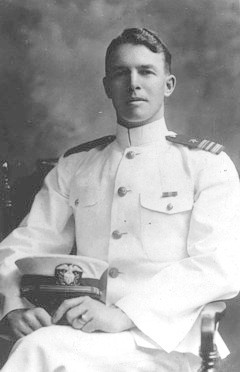
Length: 315' 6" overall.1
Beam: 31' 2" extreme.1
Displacement: 1,125 normal.1
Draft: 8' 1" mean.1
Propulsion: 4 x Thornycroft boilers; Parsons geared turbines manufactured by Norfolk Navy Yard; 20,000 shp; 2 shafts.3
Designed Speed: 32 knots.2
Fuel bunkerage: 205 tons full load (95%).1
Endurance: 7,800 nm at 12 knots.3
Designed Complement: 5 officers; 95 enlisted.1
1 Bureau of Construction and Repair’s General Information book for Craven.
2 Bauer and Roberts.
3 Friedman.
Torpedo Battery: 12 x 21-inch torpedo tubes in four triple mounts.
Main Gun Battery: 4 x 4-inch/50 caliber rapid fire guns in open pedestal mounts.
Secondary Gun Battery: 2 x 1 pdr.; 2 x .30 cal. in single mounts.
Anti-submarine Battery: 1 x 6-inch Y-gun.
Craven cruised on the East Coast and in the Caribbean in training, maneuvers and torpedo practice until 3 May 1919, when she sailed from New York for Trepassey Bay, Newfoundland. Here she served on a weather station and observed the flight of Navy seaplanes in the historic first aerial crossing of the Atlantic. After overhaul, Craven participated in Army gun tests at Fort Story, Virginia and had recruiting duty at Hampton Roads, Virginia, Fall River, Massachusetts and Newport, Rhode Island until placed in reserve at Philadelphia 10 October 1919.

LCdr. Millington Barnett McComb, Craven’s first commanding officer; died at Pearl Harbor when a wing came off his plane, 26 November 1927, while commanding officer of the Naval Air Station, Ford Island.
For service in World War I, he was awarded the newly-established Navy Distinguished Service Medal, second in order of precedence at the time, behind the Congressional Medal of Honor and ahead of the Navy Cross.
Still in reduced commission, Craven arrived at Charleston, South Carolina 10 February 1921. She transported liberty parties between Charleston and Jacksonville, Florida, and took part in fleet maneuvers off Virginia and in Narragansett Bay. Arriving at Philadelphia 29 March 1922, Craven was placed out of commission 15 June 1922. On 12 November 1939 she was renamed Conway.
Recommissioned 9 August 1940, Conway arrived at Halifax, Nova Scotia, 17 October. Here she was decommissioned 23 October 1940 and turned over to British authorities in the land bases for destroyers exchange. She was commissioned HMS Lewes the same day.
Lewes departed Halifax 1 November and arrived at Belfast, Northern Ireland, 9 November, searching for the German pocket battleship Admiral Scheer during her passage. She was refitted at Plymouth, England and ordered to remain there under the command of Commander-in-Chief, Plymouth. Severely damaged in enemy air raids 21 and 22 April 1941, she remained out of action until December when she joined the Home Fleet.
In February 1942, Lewes joined Rosyth Escort Force, escorting convoys between the Thames and the Firth of Forth, Scotland. On 9 and 10 November 1942 she engaged German E-boats, which attacked her convoy off Lowestoft. She escorted a troop convoy on its way to the Middle East and arrived at Simonstown, Union of South Africa, 18 May 1943. As well as serving as target for aircraft during their training, she searched for enemy submarines reported rounding Cape of Good Hope.
In 1944, Lewes joined the Eastern Fleet as a submarine tender and torpedo target ship. She departed Durban 13 August and arrived at Ceylon a month later. She was based at Trincomalee until January 1945, when she was transferred to the British Pacific Fleet as a target ship for aircraft training. Arriving at Fremantle, Australia, 11 February 1945, she shifted to Sydney 20 February and remained there until the end of hostilities.
On 12 October 1945, Lewes was reported as no longer necessary to the fleet. The last of the “Town”-class destroyers, she was scuttled off Sydney on 25 May 1946.
Sources: McComb family collection, Naval History & Heritage Command Photographic Section and DANFS.